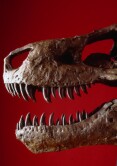
THURSDAY, Dec. 10 (HealthDay News) — Fossils found in New Mexico show that early meat-eating dinosaurs crossed continents, a new study reports.
Researchers found 213-million-year-old fossils of a previously unknown carnivorous dinosaur that had evolutionary roots in South America.
“This new dinosaur, Tawa hallae, changes our understanding of the relationships of early dinosaurs and provides fantastic insight into the evolution of the skeleton of the first carnivorous dinosaurs,” the study’s co-author, Randall Irmis, of the Utah Museum of Natural History at the University of Utah, said in a news release from the museum.
Dinosaurs first appeared 230 million years ago when the continents were part of a single landmass called Pangea. Based on their analysis of the relationships between Tawa and other early dinosaurs, the researchers concluded that dinosaurs originated in a part of Pangea that is now South America. They diverged into different groups and dispersed across parts of Pangea that later became separate continents.
“If you have continents splitting apart, you get isolation,” lead author Sterling Nesbitt, of the University of Texas at Austin, said in the release. “So when barriers develop, you would expect that multiple carnivorous dinosaurs in a region should represent a closely related endemic radiation. But that is what we don’t see in early dinosaur evolution.”
Nesbitt and his colleagues found fossils of three distinct Triassic-era dinosaurs, including Tawa, at Hayden Quarry in northern New Mexico.
“When we analyzed the evolutionary relationships of these dinosaurs, we discovered that they were only distantly related and that each species had close relatives in South America,” Irmis said. “This implies that each carnivorous dinosaur species descended from a separate lineage before arriving in [the part of Pangea that is now] North America, instead of all evolving from a local ancestor.”
A report on the finding is in the Dec. 11 issue of Science.
More information
The Smithsonian National Museum of Natural History has more about dinosaur evolution.

